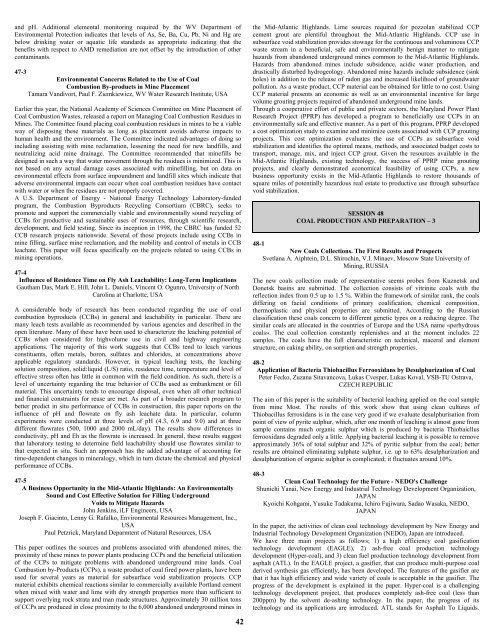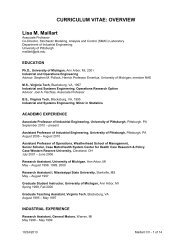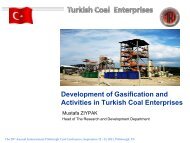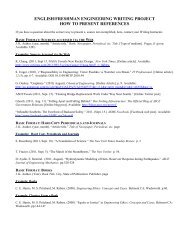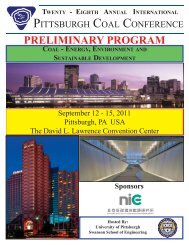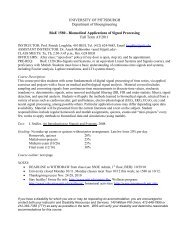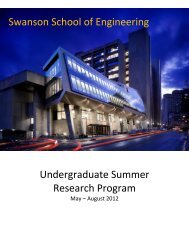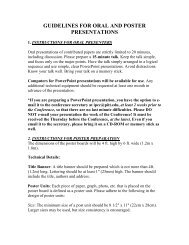Abstract Booklet 2006 - Swanson School of Engineering - University ...
Abstract Booklet 2006 - Swanson School of Engineering - University ...
Abstract Booklet 2006 - Swanson School of Engineering - University ...
Create successful ePaper yourself
Turn your PDF publications into a flip-book with our unique Google optimized e-Paper software.
and pH. Additional elemental monitoring required by the WV Department <strong>of</strong><br />
Environmental Protection indicates that levels <strong>of</strong> As, Se, Ba, Cu, Pb, Ni and Hg are<br />
below drinking water or aquatic life standards as appropriate indicating that the<br />
benefits with respect to AMD remediation are not <strong>of</strong>fset by the introduction <strong>of</strong> other<br />
contaminants.<br />
47-3<br />
Environmental Concerns Related to the Use <strong>of</strong> Coal<br />
Combustion By-products in Mine Placement<br />
Tamara Vandivort, Paul F. Ziemkiewicz, WV Water Research Institute, USA<br />
Earlier this year, the National Academy <strong>of</strong> Sciences Committee on Mine Placement <strong>of</strong><br />
Coal Combustion Wastes, released a report on Managing Coal Combustion Residues in<br />
Mines. The Committee found placing coal combustion residues in mines to be a viable<br />
way <strong>of</strong> disposing these materials as long as placement avoids adverse impacts to<br />
human health and the environment. The Committee indicated advantages <strong>of</strong> doing so<br />
including assisting with mine reclamation, lessening the need for new landfills, and<br />
neutralizing acid mine drainage. The Committee recommended that minefills be<br />
designed in such a way that water movement through the residues is minimized. This is<br />
not based on any actual damage cases associated with minefilling, but on data on<br />
environmental effects from surface impoundment and landfill sites which indicate that<br />
adverse environmental impacts can occur when coal combustion residues have contact<br />
with water or when the residues are not properly covered.<br />
A U.S. Department <strong>of</strong> Energy - National Energy Technology Laboratory-funded<br />
program, the Combustion Byproducts Recycling Consortium (CBRC), seeks to<br />
promote and support the commercially viable and environmentally sound recycling <strong>of</strong><br />
CCBs for productive and sustainable uses <strong>of</strong> resources, through scientific research,<br />
development, and field testing. Since its inception in 1998, the CBRC has funded 52<br />
CCB research projects nationwide. Several <strong>of</strong> those projects include using CCBs in<br />
mine filling, surface mine reclamation, and the mobility and control <strong>of</strong> metals in CCB<br />
leachate. This paper will focus specifically on the projects related to using CCBs in<br />
mining operations.<br />
47-4<br />
Influence <strong>of</strong> Residence Time on Fly Ash Leachability: Long-Term Implications<br />
Gautham Das, Mark E. Hill, John L. Daniels, Vincent O. Ogunro, <strong>University</strong> <strong>of</strong> North<br />
Carolina at Charlotte, USA<br />
A considerable body <strong>of</strong> research has been conducted regarding the use <strong>of</strong> coal<br />
combustion byproducts (CCBs) in general and leachability in particular. There are<br />
many leach tests available as recommended by various agencies and described in the<br />
open literature. Many <strong>of</strong> these have been used to characterize the leaching potential <strong>of</strong><br />
CCBs when considered for highvolume use in civil and highway engineering<br />
applications. The majority <strong>of</strong> this work suggests that CCBs tend to leach various<br />
constituents, <strong>of</strong>ten metals, boron, sulfates and chlorides, at concentrations above<br />
applicable regulatory standards. However, in typical leaching tests, the leaching<br />
solution composition, solid:liquid (L/S) ratio, residence time, temperature and level <strong>of</strong><br />
effective stress <strong>of</strong>ten has little in common with the field condition. As such, there is a<br />
level <strong>of</strong> uncertainty regarding the true behavior <strong>of</strong> CCBs used as embankment or fill<br />
material. This uncertainty tends to encourage disposal, even when all other technical<br />
and financial constraints for reuse are met. As part <strong>of</strong> a broader research program to<br />
better predict in situ performance <strong>of</strong> CCBs in construction, this paper reports on the<br />
influence <strong>of</strong> pH and flowrate on fly ash leachate data. In particular, column<br />
experiments were conducted at three levels <strong>of</strong> pH (4.3, 6.9 and 9.0) and at three<br />
different flowrates (500, 1000 and 2000 mL/day). The results show differences in<br />
conductivity, pH and Eh as the flowrate is increased. In general, these results suggest<br />
that laboratory testing to determine field leachability should use flowrates similar to<br />
that expected in situ. Such an approach has the added advantage <strong>of</strong> accounting for<br />
time-dependent changes in mineralogy, which in turn dictate the chemical and physical<br />
performance <strong>of</strong> CCBs.<br />
47-5<br />
A Business Opportunity in the Mid-Atlantic Highlands: An Environmentally<br />
Sound and Cost Effective Solution for Filling Underground<br />
Voids to Mitigate Hazards<br />
John Jenkins, iLF Engineers, USA<br />
Joseph F. Giacinto, Lenny G. Rafalko, Environmental Resources Management, Inc.,<br />
USA<br />
Paul Petzrick, Maryland Deparmtent <strong>of</strong> Natural Resources, USA<br />
This paper outlines the sources and problems associated with abandoned mines, the<br />
proximity <strong>of</strong> these mines to power plants producing CCPs and the beneficial utilization<br />
<strong>of</strong> the CCPs to mitigate problems with abandoned underground mine lands. Coal<br />
Combustion by-Products (CCPs), a waste product <strong>of</strong> coal fired power plants, have been<br />
used for several years as material for subsurface void stabilization projects. CCP<br />
material exhibits chemical reactions similar to commercially available Portland cement<br />
when mixed with water and lime with dry strength properties more than sufficient to<br />
support overlying rock strata and man made structures. Approximately 30 million tons<br />
<strong>of</strong> CCPs are produced in close proximity to the 6,000 abandoned underground mines in<br />
42<br />
the Mid-Atlantic Highlands. Lime sources required for pozzolan stabilized CCP<br />
cement grout are plentiful throughout the Mid-Atlantic Highlands. CCP use in<br />
subsurface void stabilization provides stowage for the continuous and voluminous CCP<br />
waste stream in a beneficial, safe and environmentally benign manner to mitigate<br />
hazards from abandoned underground mines common to the Mid-Atlantic Highlands.<br />
Hazards from abandoned mines include subsidence, acidic water production, and<br />
drastically disturbed hydrogeology. Abandoned mine hazards include subsidence (sink<br />
holes) in addition to the release <strong>of</strong> radon gas and increased likelihood <strong>of</strong> groundwater<br />
pollution. As a waste product, CCP material can be obtained for little to no cost. Using<br />
CCP material presents an economic as well as an environmental incentive for large<br />
volume grouting projects required <strong>of</strong> abandoned underground mine lands.<br />
Through a cooperative effort <strong>of</strong> public and private sectors, the Maryland Power Plant<br />
Research Project (PPRP) has developed a program to beneficially use CCPs in an<br />
environmentally safe and effective manner. As a part <strong>of</strong> this program, PPRP developed<br />
a cost optimization study to examine and minimize costs associated with CCP grouting<br />
projects. This cost optimization evaluates the use <strong>of</strong> CCPs as subsurface void<br />
stabilization and identifies the optimal means, methods, and associated budget costs to<br />
transport, manage, mix, and inject CCP grout. Given the resources available in the<br />
Mid-Atlantic Highlands, existing technology, the success <strong>of</strong> PPRP mine grouting<br />
projects, and clearly demonstrated economical feasibility <strong>of</strong> using CCPs, a new<br />
business opportunity exists in the Mid-Atlantic Highlands to restore thousands <strong>of</strong><br />
square miles <strong>of</strong> potentially hazardous real estate to productive use through subsurface<br />
void stabilization.<br />
SESSION 48<br />
COAL PRODUCTION AND PREPARATION – 3<br />
48-1<br />
New Coals Collections. The First Results and Prospects<br />
Svetlana A. Aiphtein, D.L. Shirochin, V.I. Minaev, Moscow State <strong>University</strong> <strong>of</strong><br />
Mining, RUSSIA<br />
The new coals collection made <strong>of</strong> representative seems probes from Kuznetsk and<br />
Donetsk basins are submitted. The collection consists <strong>of</strong> vitrinite coals with the<br />
reflection index from 0.5 up to 1.5 %. Within the framework <strong>of</strong> similar rank, the coals<br />
differing on facial conditions <strong>of</strong> primary coalification, chemical composition,<br />
thermoplastic and physical properties are submitted. According to the Russian<br />
classification these coals concern to different genetic types on a reducing degree. The<br />
similar coals are allocated in the countries <strong>of</strong> Europe and the USA name «perhydrous<br />
coals». The coal collection constantly replenishes and at the moment includes 22<br />
samples. The coals have the full characteristic on technical, maceral and element<br />
structure, on caking ability, on sorption and strength properties.<br />
48-2<br />
Application <strong>of</strong> Bacteria Thiobacillus Ferrooxidans by Desulphurization <strong>of</strong> Coal<br />
Peter Fecko, Zuzana Sitavancova, Lukas Cvesper, Lukas Koval, VSB-TU Ostrava,<br />
CZECH REPUBLIC<br />
The aim <strong>of</strong> this paper is the suitability <strong>of</strong> bacterial leaching applied on the coal sample<br />
from mine Most. The results <strong>of</strong> this work show that using clean cultures <strong>of</strong><br />
Thiobacillus ferroxidans is in the case very good if we evaluate desulphurisation from<br />
point <strong>of</strong> view <strong>of</strong> pyrite sulphur, which, after one month <strong>of</strong> leaching is almost gone from<br />
sample contains much organic sulphur which is produced by bacteria Thiobaicllus<br />
ferrooxidans degraded only a little. Applying bacterial leaching it is possible to remove<br />
approximately 36% <strong>of</strong> total sulphur and 32% <strong>of</strong> pyritic sulphur from the coal; better<br />
results are obtained eliminating sulphate sulphur, i.e. up to 63% desulphurization and<br />
desulphurization <strong>of</strong> organic sulphur is complicated; it fluctuates around 10%.<br />
48-3<br />
Clean Coal Technology for the Future - NEDO's Challenge<br />
Shunichi Yanai, New Energy and Industrial Technology Development Organization,<br />
JAPAN<br />
Kyoichi Kohgami, Yusuke Tadakuma, Ichiro Fujiwara, Sadao Wasaka, NEDO,<br />
JAPAN<br />
In the paper, the activities <strong>of</strong> clean coal technology development by New Energy and<br />
Industrial Technology Development Organization (NEDO), Japan are introduced.<br />
We have three main projects as follows; 1) a high efficiency coal gasification<br />
technology development (EAGLE), 2) ash-free coal production technology<br />
development (Hyper-coal), and 3) clean fuel production technology development from<br />
asphalt (ATL). In the EAGLE project, a gasifier, that can produce multi-purpose coal<br />
derived synthesis gas efficiently, has been developed. The features <strong>of</strong> the gasifier are<br />
that it has high efficiency and wide variety <strong>of</strong> coals is acceptable in the gasifier. The<br />
progress <strong>of</strong> the development is explained in the paper. Hyper-coal is a challenging<br />
technology development project, that produces completely ash-free coal (less than<br />
200ppm) by the solvent de-ashing technology. In the paper, the progress <strong>of</strong> its<br />
technology and its applications are introduced. ATL stands for Asphalt To Liquids.


